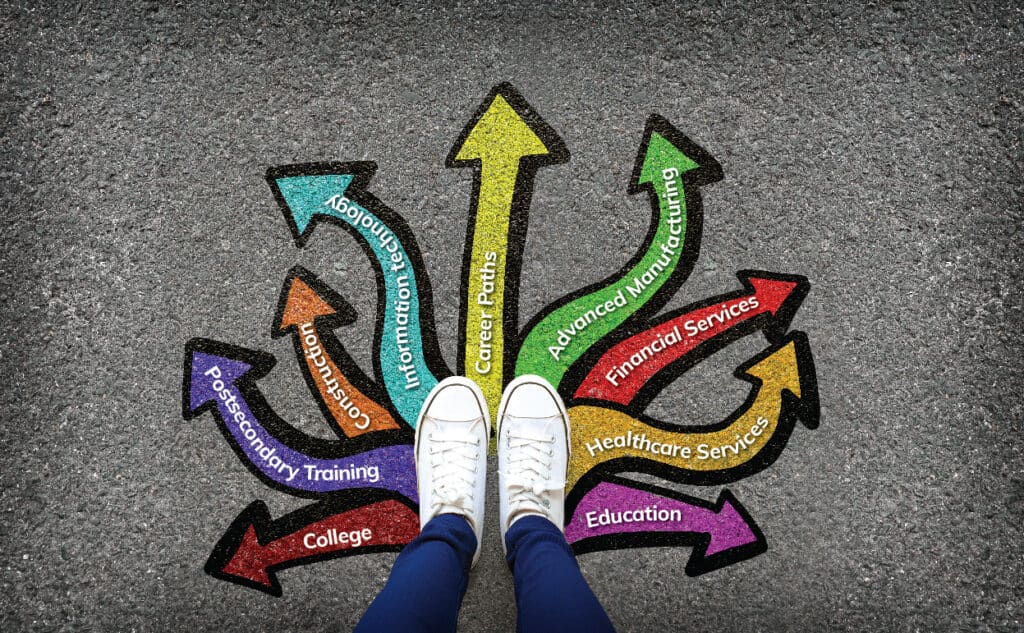This essay appearing in The 74 was originally published as part of the Center on Reinventing Public Education’s “State of the American Student 2023.” As part of the effort, CRPE asked 14 experts from various sectors to offer examples of innovations, solutions or possible paths forward as education leaders navigate post-pandemic challenges.
The United States has an education problem—low and declining test scores, disengaged students and growing teacher shortages, among other challenges. In Indiana, fewer high school students are pursuing postsecondary education or completing a credential or degree. This decline in postsecondary enrollment and educational attainment is sharpest for Black and Hispanic/Latino students, especially males.
We also have a skills gap problem—not enough people with the skills to handle the jobs of the future—and the pandemic has accelerated this misalignment in supply and demand. In Indianapolis alone, at last count, we needed 215,000 people with job-ready credentials to close our skills gap.
Traditional approaches aren’t working. Communities like ours must become much more innovative if we wish to ensure a future of inclusive economic prosperity.
We leverage a continuum of career-connected learning to ensure Indy’s youth and young adults are positioned to meet the future needs of the local economy. This continuum includes a broad array of exploration, engagement and experience opportunities.
One of our most ambitious initiatives is a reinvented approach to apprenticeship, a job training model that dates back to the Middle Ages. Through the Modern Apprenticeship Program, which we operate with a sister intermediary, Ascend Indiana, we’re preparing high school students for the jobs of the future. By blurring the lines between education and work, we’re making learning more relevant for students. We’re creating more pathways to prosperity for all students, with a particular focus on the underserved, underrepresented and underprivileged in our community.
More than 40 participating local employers and 14 high schools have come together to co-develop talent, offering apprenticeships across seven industries with the highest student interest:
- Healthcare services
- Information technology
- Business operations
- Advanced manufacturing
- Construction
- Education
- Financial services
Specific jobs range from project coordinators and staff accountants to maintenance technicians and IT support.
High school students earn while they learn. As juniors, they spend two days a week on the job, which increases to three days as seniors. One year after graduation, young adults have earned a high school diploma, college credits and industry credentials. They have built a professional network. And they have a choice for their next step—college, postsecondary training or work. What parent wouldn’t want that for their 18-year-old?
We’re helping diversify our workforce: about 88% of current apprentices are students of color, 60% are female, and one-third come from low-income households, doing jobs such as IT and accounting that historically have been dominated by white men.
We’re reducing employer turnover: 94% of Indiana employees say they would stay with their companies longer if they invested in learning. And we’re having a positive return on investment: every $1 invested in apprenticeship returns $1.47.
Our primary challenge now is to expand what’s working. We’ve incubated success. Now we must scale it. Doing so will require all parties to adjust how they do business in the 21st century.
Employers need to play a much bigger, more well-defined role in this new system. They must cocreate learning opportunities, advise on occupations and curriculum, become training companies for apprentices, and invest more time and treasure to ensure education and government partners are providing the most comprehensive education possible to young people. They need to engage their future workforce early, starting in middle school, and not wait until unprepared graduates fill out a job application.
High schools must continue to become more flexible, offering students more choices and pathways. They must work with their community partners to ensure all students are receiving the career-coaching support needed to make important decisions about their future. Graduation day must be seen as the starting line, not the endpoint.
Young people themselves must step up and benefit from the growing opportunities to take charge of their own learning. Of course, they need to learn math, science and reading. But just as important, they need a career plan. And they need to master durable skills such as problem solving, teamwork and conflict resolution that will help them in school–and in life.
One of our most innovative programs, YES Indy, invites out-of-school youth to play basketball at reengagement centers (RECs) as a first step in building the trust needed for them to reengage with school and work. The Indianapolis area has more than 30,000 such young people. It costs us about $12,500 each to reengage with them—a smart investment, considering it costs society three times more if they continue to stay out of school or work.
The 74






